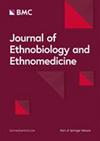Legendary fermented herbs: an ethnobotanical study of the traditional fermentation starter of the Chuanqing people in Northwestern Guizhou, China
IF 3.7
2区 医学
Q1 BIODIVERSITY CONSERVATION
引用次数: 0
Abstract
Plants that contain brewing microorganisms are used in traditional fermentation starters, which are an essential part of local diet, nutrition, life, and health. Regionally, the plant species used and the microorganisms included in traditional fermentation starters are diverse, endowing local fermented drinks with different flavors and health benefits. However, related traditional knowledge has been scarcely documented or revealed. An ethnobotanical survey was conducted in five towns of Nayong County in northwestern Guizhou, China. Snowball sampling, semi-structured interviews, free lists, and participatory observation were used to collect information on Jiuqu Plants (JPs) and jiuqu-making techniques. The PacBio platform was used to study the microbial community structure and diversity in the Chuanqing people’s jiuqu. In total, 225 informants were interviewed, including 116 who provided plants and technological processes for making Chinese baijiu jiuqu (CBJ) and 139 who provided information about making fermented glutinous rice jiuqu (FGRJ). This study found that older people have more abundant knowledge about CBJ plants. Poaceae was found to be the dominant family used in making CBJ and FGRJ (7 species each). Compared to individual plant parts, the whole plant is most commonly used in two kinds of jiuqu (19.5% in CBJ and 22.6% in FGRJ). The Chuanqing people’s jiuqu is used to treat dietary stagnation and indigestion. The highest relative frequency of citation of the CBJ plant was Ficus tikoua Bureau, and the counterpart of the FGRJ plant was Buddleja macrostachya Benth. The dominant bacterial species in jiuqu were Gluconobacter japonicus (YQ1, YQ4) and Pediococcus pentosaceus (YQ2, YQ3), and the dominant fungal species was Rhizopus oryzae. For the first time, this study documents the unique traditional jiuqu knowledge and reveals the microbial mystery behind the FGRJ of the Chuanqing people. Therefore, this study encourages the use of online social media platforms in order to spread Jiuqu culture, the use of the new media wave in order to create multimedia databases, and also suggests that local communities should develop preservation intervention programs, in addition to nurturing the inheritors in order to prevent the disappearance of traditional Jiuqu knowledge. This research contributes to the conservation and demystification of the traditional jiuqu knowledge of the Chuanqing people and lays the foundation for further research on its microbiology, nutrition, and metabolomics.传说中的发酵草药:对中国贵州西北部川庆人传统发酵启动器的民族植物学研究
含有酿造微生物的植物被用于传统发酵起泡剂,这是当地饮食、营养、生活和健康的重要组成部分。从地区上看,传统发酵起泡剂中使用的植物种类和包含的微生物多种多样,赋予了当地发酵饮料不同的风味和保健功效。然而,相关的传统知识却鲜有记载或揭示。本研究在中国贵州省西北部纳雍县的五个乡镇开展了一项民族植物学调查。调查采用了滚雪球抽样、半结构式访谈、自由列表和参与式观察等方法,以收集有关九曲植物(JPs)和九曲制作技术的信息。利用 PacBio 平台研究了川庆人九曲中的微生物群落结构和多样性。本研究共访问了 225 位信息提供者,其中 116 位提供了制作中国白酒九曲(CBJ)的植物和工艺流程,139 位提供了制作发酵糯米九曲(FGRJ)的信息。研究发现,老年人对中国白酒植物的了解更为丰富。研究发现,用于制作 CBJ 和发酵糯米九曲的植物主要是豆科植物(各 7 种)。与植物的单个部分相比,两种九曲中最常用的是全草(在 CBJ 中占 19.5%,在 FGRJ 中占 22.6%)。川庆人的九曲用于治疗饮食积滞和消化不良。CBJ 植物中相对引用频率最高的是薜荔(Ficus tikoua Bureau),而 FGRJ 植物中相对引用频率最高的是百日草(Buddleja macrostachya Benth)。九曲中的优势细菌种类为日本葡萄糖菌(YQ1,YQ4)和五味子球菌(YQ2,YQ3),优势真菌种类为根瘤菌(Rhizopus oryzae)。本研究首次记录了独特的传统九曲知识,揭示了川庆人 "九曲 "背后的微生物奥秘。因此,本研究鼓励利用网络社交媒体平台传播九曲文化,利用新媒体浪潮创建多媒体数据库,并建议地方社区在培养传承人的同时制定保护干预计划,以防止传统九曲知识的消失。这项研究有助于保护和解密川庆人的传统九曲知识,并为进一步研究其微生物学、营养学和代谢组学奠定了基础。
本文章由计算机程序翻译,如有差异,请以英文原文为准。
求助全文
约1分钟内获得全文
求助全文
来源期刊

Journal of Ethnobiology and Ethnomedicine
PHARMACOLOGY & PHARMACY-
CiteScore
7.30
自引率
16.70%
发文量
66
审稿时长
>12 weeks
期刊介绍:
Journal of Ethnobiology and Ethnomedicine publishes original research focusing on cultural perceptions of nature and of human and animal health. Journal of Ethnobiology and Ethnomedicine invites research articles, reviews and commentaries concerning the investigations of the inextricable links between human societies and nature, food, and health. Specifically, the journal covers the following topics: ethnobotany, ethnomycology, ethnozoology, ethnoecology (including ethnopedology), ethnogastronomy, ethnomedicine, ethnoveterinary, as well as all related areas in environmental, nutritional, and medical anthropology.
Research focusing on the implications that the inclusion of humanistic, cultural, and social dimensions have in understanding the biological word is also welcome, as well as its potential projections in public health-centred, nutritional, and environmental policies.
 求助内容:
求助内容: 应助结果提醒方式:
应助结果提醒方式:


